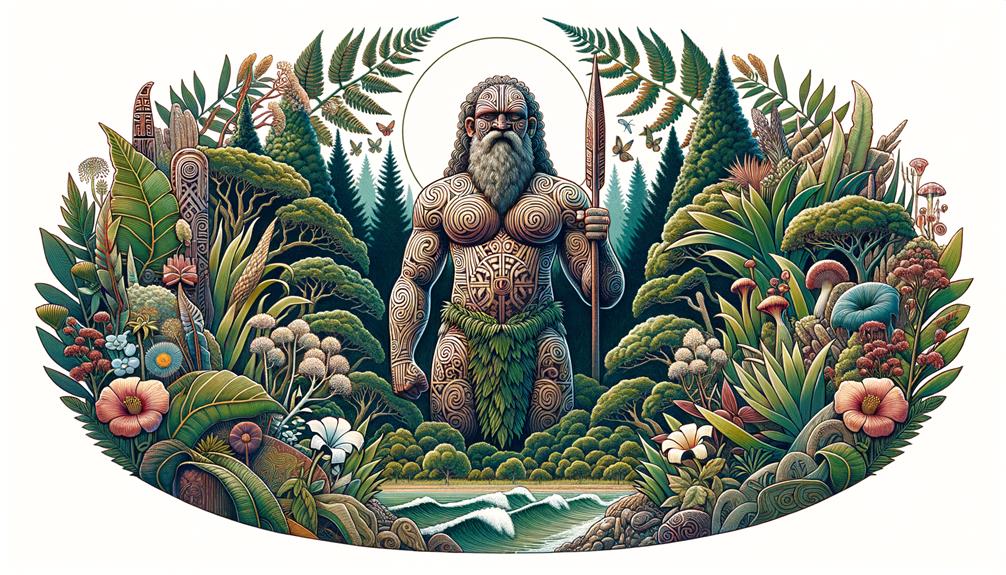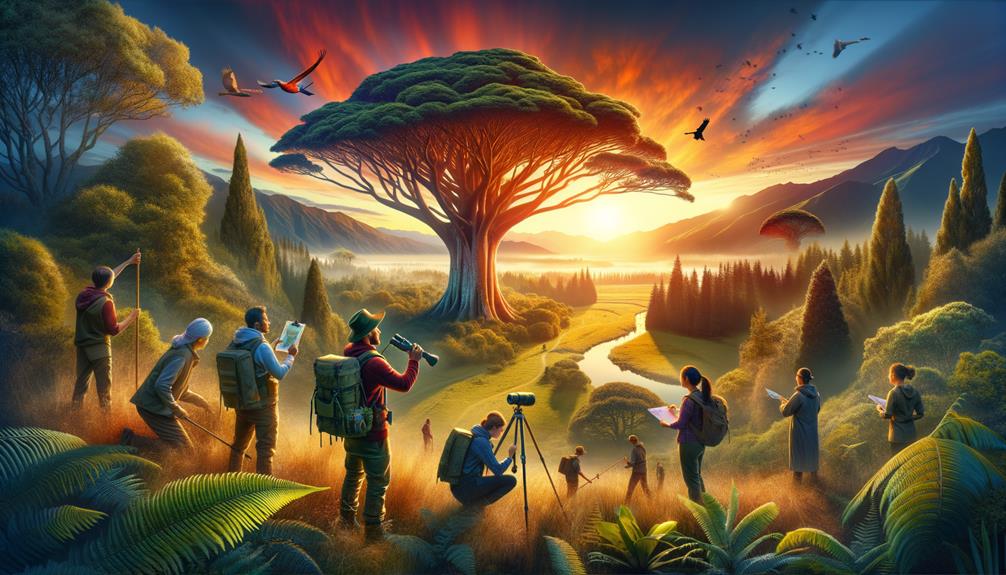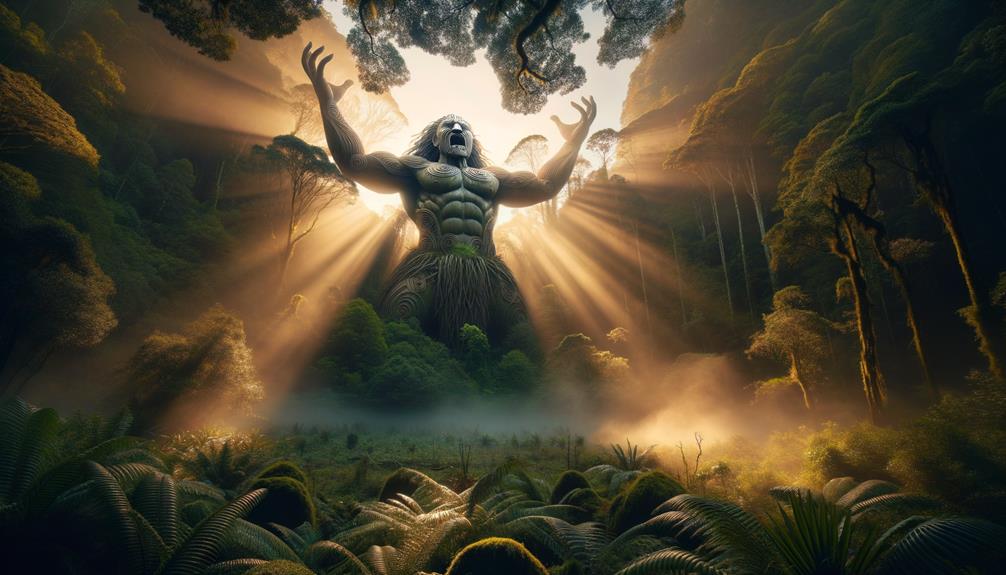'Tane and the Dawn of Forests' is an intriguing journey into the role of Tane Mahuta in Maori mythology. Tane's intelligent foresight is something to marvel at, as he parted the Earth and Sky, introducing light and instigating the creation of rich forests. He's more than just a deity of the woods; his impact is deeply ingrained in Maori culture, influencing traditions, ceremonies, and their relationship with the environment. The threat of the Kauri dieback disease puts these age-old forests at risk, but New Zealand's commitment to preserving them is steadfast. Tane's story is packed with wisdom, and as you delve further into this forest of knowledge, you gain more understanding.
Exploring Tane Mahutas Mythology
Let's chat about Maori mythology and Tane Mahuta, the forest god. His most notable act was separating his parents, the Earth and the Sky, which brought light into our world. This wasn't simply a physical event; it was a symbol of leadership and the beginning of a new era. Tane's ability to understand the importance of light shows his strategic thinking, crucial in leading his people from obscurity to enlightenment.
Further into Tane's mythology, we realize that this act of separation illustrates the Maori's deep respect for the natural world. Tane's parents, the Earth and Sky, symbolize the connection between all the elements in our world. Tane's role in this separation highlights his importance in Maori creation stories, embodying wisdom, leadership, and the spirit of the forest itself.
In a nutshell, Tane's mythology is a story of change and enlightenment. His bold move of separating Earth and Sky is more than just bringing light into the world; it's also an example of the leadership and wisdom that are integral to Maori culture. Tane's story gives us a glimpse into the profound depths of Maori wisdom and their view of the universe.
Tanes Role in Creation

When we talk about Tane and his role in creation, it's absolutely vital to talk about one key action – the separation of his parents, Earth and Sky. This wasn't just an ordinary act; it brought light into the world and kicked off a brand new chapter. And Tane wasn't just about bringing light into the world. As the god of forests and trees, his importance goes way beyond that.
He also filled the sky with celestial bodies – stars, the moon, and the sun – adding another layer to his legacy. Just look around, and you'll see Tane's influence in the lush forests around us. It's a testament to his creativity. His relationship with the natural world is deep, and his wisdom shines through in the beautifully balanced ecosystem that he created.
What really stands out, though, is Tane's creation of the first man, Tiki. In doing so, he didn't just populate the world, he added diversity to it, bringing in insects, birds, and plants. In Maori culture, this symbolizes enlightenment, and it speaks to the power of knowledge to transform the world. Indeed, Tane's role in creation isn't just about physical growth. It's also about intellectual and spiritual growth, a theme that's woven throughout Maori culture.
The Impact on Māori Culture

Let's turn our focus from the grand cosmic feats of Tane to how his deeds shaped the Māori culture in a more personal way. It's undeniable that Tane-Mahuta, being responsible for dressing the Earth in trees and ferns, heavily influenced the sacred respect for forests in Polynesian-Māori customs. The worship of Tane-Mahuta as the forest deity deeply impacted their spiritual bond with nature.
Let's take a look at some of the cultural expressions this manifested in:
| Cultural Expressions | Interpretation |
|---|---|
| Rituals and Ceremonies | Acts carried out when cutting down trees like totara, showing a deep respect for the forest. |
| Symbolism | Forest elements like puriri and Prince of Wales feather ferns carried significant meaning in rituals and ceremonies. |
| Offerings | Gifts given to birds and sacred stones in the forest, promoting abundance and nourishment. |
| Maori Traditions | Sayings like 'Te waha o Tane' and 'Ka kata nga puriri o Taiamai' show the close relationship between forest elements and Maori beliefs. |
These practices highlight a diverse range of cultural expressions. Each aspect is laced with threads of sacred respect and honour for Tane-Mahuta. This complex network of beliefs, rituals, and symbols form the lively heart of Maori traditions, showcasing their deep spiritual bond with the forest.
Threats to Kauri Forests
In the heart of the forest, the towering Kauri trees, descendants of Tane-Mahuta, face a grave risk – a disease called Kauri dieback. This disease is a formidable enemy that casts a dark shadow over our cherished Kauri forests. Once hit by this disease, the trees go through a slow and painful death, transforming our lush forests into fields of decaying giants.
We've geared up to protect these tree guardians with strict actions and isolation rules. Anyone visiting these sacred woods now needs to clean their shoes, a simple act that forms a key line of defense against Kauri dieback. We're also channeling rivers in a different direction, another significant step to keep the disease at bay and shield the endangered Kauri from impending doom.
Managing conservation is just as critical in this fight. We've come up with comprehensive plans with one objective – ensuring the survival of Kauri trees. Through intensive management and thorough monitoring, we're striving to turn the situation around in this fight against the disease.
The future of the Kauri, these ancient descendants of Tane-Mahuta, is hanging by a thread. The urgency is palpable, and the danger is near. If we don't stay alert, the Forest's Dawn could easily turn into dusk.
Conservation Efforts in New Zealand

New Zealand's conservation efforts are nothing short of remarkable, particularly when it comes to protecting the awe-inspiring Kauri trees from the persistent grip of Kauri dieback. You'll see that no effort is too small, from rerouting waterways to imposing stringent quarantine rules, these dedicated guardians of the forest stop at nothing. They're like the legendary protectors from ancient tales, valiantly battling the disease threatening these age-old giants.
Their strategies are as diverse as they are clever. One important aspect that often slips under the radar is forest management. Keeping the forest ecosystem healthy and diverse actually acts as a formidable defense line against Kauri dieback. Even small measures, like cleaning your shoes, can become mighty tools in this fight for the trees' survival.
But the job's not done yet. As we tackle the immediate threat, we're also casting our eyes to the future. Plans for ongoing conservation management are in the works, focused on the survival of the Kauri trees. But it's not just about the trees – it's about the unique ecosystem they sustain.
In this inspiring story of conservation, New Zealand serves as a shining example, showing that with determination and creativity, we have the power to safeguard our invaluable natural heritage. The battle against Kauri dieback rages on, and within it, we find our mission, our test, and our victory.
Frequently Asked Questions
What Is the Story of TāNe the God of the Forest?
In Māori folklore, Tāne is the revered deity of the forest. He's a key player in the creation story, taking on the monumental task of separating the Earth and Sky to illuminate the world. Tāne didn't stop there though. He also decorated the sky and was the creative force behind life itself. He's a powerful symbol of both creation and wisdom in the Māori culture.
What Does TāNe Mean in MāOri?
In the Māori language, 'Tāne' is the word for 'man' or 'male'. This is quite appropriate since in Māori legends, Tāne is a significant figure. He's not just any man, but the one who brought humans into existence, crafting the first man. Plus, he's known as the force behind the creation of the stunning celestial bodies. So, when you talk about Tāne, you're discussing a pretty big deal in Māori mythology.
Why Is TāNe Mahuta Important?
You see, the importance of Tāne Mahuta is deeply rooted in his role as the god of forests in the Māori culture. He's like an emblem of our bond with nature, guiding us towards enlightenment and the conservation of our environment. Plus, he's an epitome of wisdom and leadership – a true figure to look up to.
Why Did TāNe Mahuta Separate His Parents?
You might be wondering why Tāne Mahuta decided to part his parents. Well, he did it to bring light and life into the world we live in. Imagine a guy so daring and determined that he changes the entire world and creates a forest ecosystem teeming with life! Pretty impressive, right? That's why he's such a crucial figure in our origin story and why we owe so much to him in terms of environmental balance.


